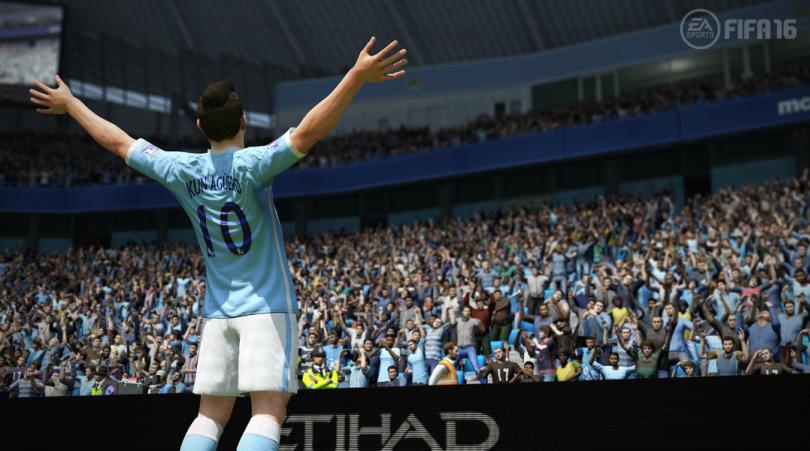How to master the passing on FIFA 16: FourFourTwo's essential guide
Official game guide writer James Price offers 14 tips and nuggets of advice – including videos – on how to improve your game... imperative reading for your one-upmanship!

EA’s decision to overhaul the passing and first-touch mechanics in FIFA 16 is proving contentious in certain quarters, with passing purists, long-ball merchants and sweaty pace abusers alike bemoaning the current state of play.
Truth is, ball distribution in FIFA 16 isn’t the trainwreck that some people would have you believe. There are, granted, occasional passes that feel entirely arbitrary and at odds with what you asked for, not to mention glitches, idiosyncrasies and game balance issues that we’d like to see addressed. Take the time to really come to terms with the general pace and focus of this new edition, though, and you’ll find that every FIFA player archetype has the tools to play their favoured style of game – and enjoy it.
The following tips, tactics and tricks have been written with online play in mind, but many of the techniques will translate into single-player sessions. If you’re struggling in general, we’d advise that you head to Seasons mode to practice in a realistic, live-fire environment: this way, there’s less chance that you’ll encounter the squads of human bulldozers that savvy Ultimate Team players are assembling. That said, stick to teams of a no more than a four-and-a-half star rating to avoid an interminable succession of Real Madrid fanboys. Those guys are arseholes, and you’ll learn little by filling the air with choice invective as they run Ronaldo in inexplicably effective straight lines.
1. Resist the urge to sprint
So important, it’s the first entry in the list. Sprinting reduces pass accuracy, and makes your players easier to tackle. Until there’s a specific opportunity to inject a burst of pace, it’s much, much easier to maintain possession if you walk with the ball.
Once you get into a rhythm, you can frustrate an opponent who favours a high-intensity pressure game (so: approximately 97.2% of all Ultimate Team adversaries) with a simple pass-and-move approach, largely because walking players aren’t tracked as aggressively by the AI assistance that can transform defending teams into swarms of homing missiles.
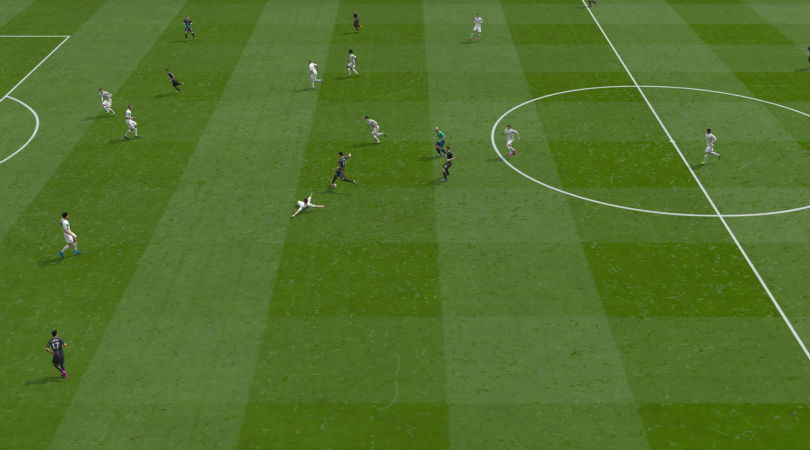
With subtle turns and walking-pace football, slide tackles become less potent. You’ll know you’ve got the rhythm just right when your opponent’s defensive approach begins to look like a re-enactment of the iconic ice scene from Bambi.
Get FourFourTwo Newsletter
The best features, fun and footballing quizzes, straight to your inbox every week.
2. Hold the directional stick until a pass is played
This is a fundamental FIFA technique, and one that countless players forget or even fail to grasp, habitually releasing the left stick once they’ve set the strength of a pass. If the player under control then takes an extra touch, or receives a minor knock from an opponent, the delay will cause the pass to be played in the current direction that the left stick is held. In short: don’t switch off until the ball actually leaves a player’s feet.
In a similar vein, note that heavy physical pressure from an opponent in close proximity can cause a pass to be cancelled. If you see your player stumble or otherwise react to a sliding opponent, shirt tug or barge, be ready to set up a replacement pass.
3. Watch that first touch
A good first touch is equally as important as the quality of the pass that came before it. Your initial contact with the ball should always set up the next part of a move, either creating space or establishing an angle for the next pass. Try not to sprint as you receive a pass to feet: this can lead to awkward bounces and extra touches, though it’s less of an issue if you’re running onto a pass into space.
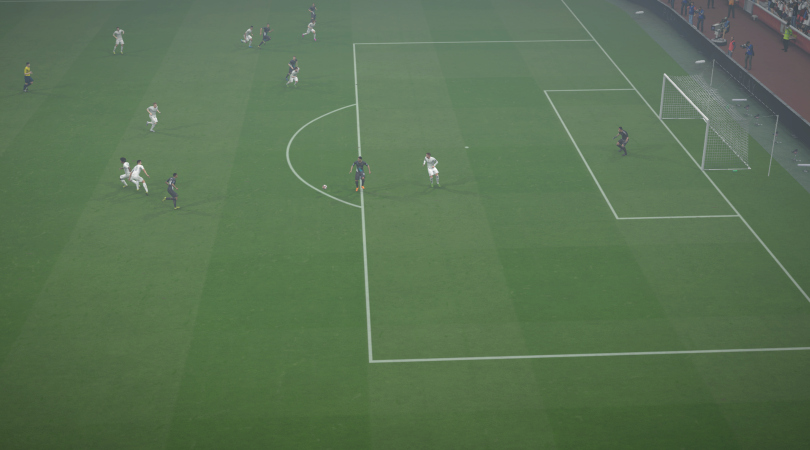
A natural instinct in this situation is to turn and attempt to beat the defender. But we also know that our opponent knows that…
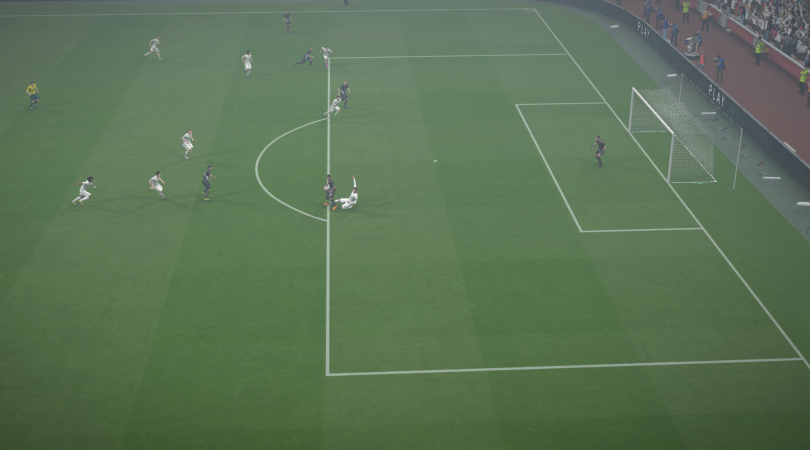
…so we turn away from his anticipated lunge (which would probably have worked had we turned to face goal), and take the gift-wrapped penalty.
4. Pick a formation, then practice to understand it
From our experience so far, it seems harder to play a possession game with formations that feature a flat bank of central midfielders.
If you want to dominate a game, you’ll need a system that gives you the necessary angles and movement.
As a general rule of thumb, we’ve found that fluid passing sequences are less likely to break down if you have a quality central attacking midfielder. A playmaker in the CAM role will habitually take up space between the lines, acting as a pivot in attacking moves, or drifting into pockets of space in and around the penalty area when the ball is played to the wings.
There is no right or wrong formation, no “magic bullet” system that conquers all others: just different ways of setting your team up. You can play some beautiful football with the ‘4-3-3 (4)’ system… but you’d better be adept at defending counter-attacks, because everyone but the two centre-backs will push forwards at the merest mention that someone, somewhere, is considering the merits of dropping a hat. Conversely, the ‘4-4-2 (2)’ is a struggle; it’s hard to play the short game, though we can see how it might work well for a percentages strategy, with driven passes drilled up to the two strikers with minimal prior build-up.

If you find that a formation has merit but isn’t quite working for you, adjustments of the team’s attack/defence level (double-tap left and right on the directional pad during the match) can be a revelation.
The 4-2-3-1 variant with wide midfielders and a single CAM is defensively sound, but it’s hard to build attacking momentum. Adjust the attack/defence level to Attacking, though, and you sacrifice a relatively small measure of stability at the back in exchange for runs and support that you’ll rarely find on the default Balanced setting. Similarly, switching that exciting but fragile 4-3-3 (4) formation to Defensive or even Ultra Defensive can put men behind the ball without completely sacrificing forward movement when you need to keep things tight in the last 10 minutes.
5. Learn to see the whole picture
If you really want to play a passing game, a zoomed-out camera view is practically a requisite. Not everyone will be able to cope with the distant but tactically excellent overview offered by the Co-op camera (especially during the new ‘cataract mode’ foggy weather conditions), but you can still choose a custom zoom level for your preferred option to provide a slightly wider view of proceedings.
It’s an unusual concept to grasp at first, but try readjusting your focus to look at the entire screen during passing moves, rather than staring intently at the individual player under your control. It’s a revelation if you can master it: you start to see passes and movement that you were oblivious to moments beforehand.
6. Go backwards to go forwards
This is a mistake that we see time and time again: players blind to options behind them, always passing to the most advanced player within reach. If a move isn’t going anywhere, or the defending team are camped in their own half, it’s better to send the ball back to deep-lying players than to risk squandering possession on a hopeful pass or cross. Maintaining ownership of the ball is the purest and most effective form of defending.
A backwards pass can open up new angles and opportunities. The most critical attacking contribution in the counter-attack shown in this clip? It’s not the initial header (it’s a weak corner), or the lofted through-ball towards the end. It’s the backwards pass in defence that provides the two key runners with a split-second to break clear of the chasing pack.
7. Use the right weight of pass
Broadly speaking, there are three weights of ground pass: the cushioned short ball (press X button/A button, then tap L2/left trigger before the pass is played), standard X button/A button distribution (with the speed determined by the direction played and length of button press), and the new driven pass where you hold R1/right bumper as a modifier with a standard pass.
With defending players much, much more adept at sticking out a foot to intercept the ball, faster passes are more likely to reach their destination, but they’re harder to control when they arrive. Slower passes are great for the receiving player – but simple for a defender who has read your intentions to steal. Building a passing move, then, is a constant struggle with risk and reward. In busy midfield areas, the general weight of pass that offers a high completion rate is usually too hard for a player to control with ease, with extra control touches killing the momentum of a move.
The solution is to integrate through-ball passes (triangle button/Y button) into your build-up play. It takes practice, and it’s not something that you can master overnight, but stroking the ball into the path of a teammate will usually leave them with their head up and ready to use it after no more than a single touch.
Passes played into space are always easier to work with than balls played to feet. Better still, they encourage all-important movement in situations where a standard pass can leave a player static.
A simple demonstration of three feathered through-balls employed to set up a tap-in.
Try to use only as much power as you need. With one eye on Mane, and having noted that our opponent liked to spring the offside trap, a little cushioned through-ball was all it took to reward a well-timed run with a goal.
8. Use more lofted passes
The lofted through-ball as you knew it in FIFA 15 – the master key to any defence, and catenaccio be damned – is a much diminished beast in FIFA 16. However, a lot of players have failed to realise that you can replicate much of its functionality with square button/X button passes.
If you have an opponent attempting to mark your passing lanes, but players in space, try a simple chip. Even if there’s a defender in attendance to contest a header, you have the advantage of being able to move into position a split-second before they do.
For any possession-based game, the crossfield ball is a mainstay that you can’t do without. When play gets congested on one side of the pitch, use a full-power lofted pass to switch the ball to the opposite flank.
Get the weight of a lofted pass just right, and they’re actually easier to control – or pass first-time – than many ground passes. You also potentially benefit from the fact that a fairly significant proportion of FIFA players struggle to contest headers in midfield areas (unless, alas, you are one of them).
9. Fight for the ball
Whenever you compete for a loose ball or pass made into space, don’t forget to tap circle button/square button to apply physical pressure if you have an opponent in close proximity.
Even if you’re ostensibly in possession at the time – that is, the ball was played by someone on your team – you can and really should use this defensive function to contest a tussle. These battles are governed by player strength stats, and now favour individuals with genuine physical presence. If you have an imposing forward such as Benteke or Lukaku up front, it’s worth risking 50/50 balls into space just to set up an opportunity to bully a relatively lightweight defender.
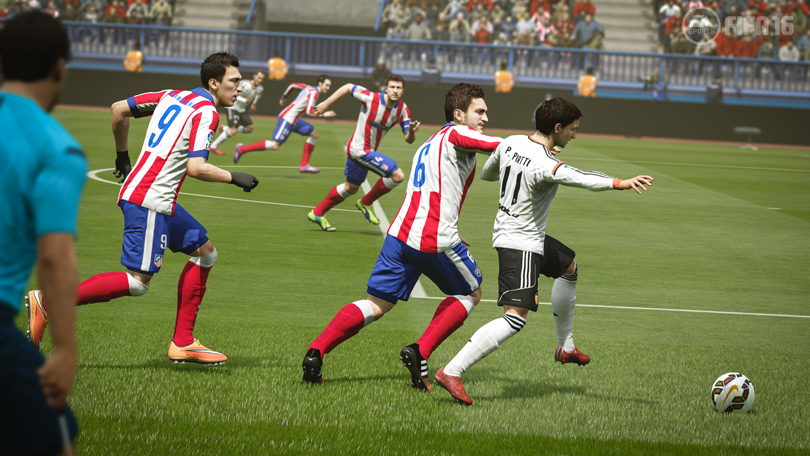
10. Use first-time passes sparingly
If there’s one error that we’re encountering more than any other in FIFA 16, it’s this. The completion rate for first-time passes is much lower than in 15, which means that sequences of so-called “ping pong passing” are liable to break down at any moment. If players have to twist or turn to play the pass, expect the accuracy to suffer accordingly. A related issue occurs whenever players attempt to make immediate passes in the split-second after gaining possession, which can lead to some truly shocking distribution. To avoid this, it’s often prudent to allow your player to take a touch or two before you pass after making an interception or winning the ball with a standing tackle.
11. Player movement is critical to a passing game
In addition to automated player runs initiated by the AI, there are three ways to create your own off-the-ball movement.
- Set up a one-two (hold L1/left bumper while making a standard pass), and the player will run forward after sending the ball to a teammate.
- Tap L2/left trigger just after you make a pass to encourage the player to run forward.
- Double-tap L1/left bumper while in possession to make a teammate you are facing (or, more precisely, pointing to with the left stick) make an off-the-ball run.
Creating, recognising and exploiting opportunities presented by player runs is the cornerstone of an intelligent passing game. It’s a technique that is really hard to teach, though: you first need to be familiar with a formation, and then learn how different players behave within that system.
A good starting point is to use the manual run functions detailed above to buy yourself an extra moment on the ball in the final third. Many players will habitually track the runner in these situations, which might give you a moment to find the killer pass that you’re looking for.
Sometimes, you need to slow a move down to create movement. After the quick turnover of possession in midfield, and the luxury of no immediate pressure, we wait for support to arrive from midfield before initiating a purposeful attack.
An example of a textbook ‘give and go’ set up with a simple, short L1/right bumper + X button/A button pass.
12. Be smart with your distribution from goal-kicks
Goal-kicks can be a trial; an interception or header after the wrong pass from the keeper can put you on the back foot and scrambling to prevent a shot within seconds.
Playing a short ball to a defender is rarely a viable option, as most online opponents are wise to that, and consistently lurk close to your backline. Punts to midfielders or strikers are also a risk: it only takes one header to return the ball to an opposition forward.
The safest method of distribution, or so we’ve found so far, is to aim for positions close to wide midfielders or wingers on the touchlines. A lofted pass that fills the power bar by three-quarters will usually be just right for the near side; something closer to full power will be required to reach the far side. As long as you move the receiving player into position before the ball arrives, you’ll generally be favourite to win the ball even if an opponent contests it. Worst-case scenario, you’ll need to immediately nod or tap it back to the full-back.
As your keeper collects the ball, check the radar for a player in space – usually wide men. Most goalies can reach a position close to the halfway line with a full-power diagonal throw. For anything in your opponent’s half, you’ll need to kick it.
13. Use driven passes to up the tempo in the final third
The new driven pass (hold R1/right bumper while powering up a standard pass) is fantastic for setting up chances, but you really need to pick the right moment: play it over a short distance, and the receiving player’s first touch can kill a move. Used with precision, though, it’s a perfect way of upping the tempo of a passing move to create a shooting opportunity. If you haven’t practiced with it yet, do so: it’s an essential part of the FIFA 16 passing repertoire.
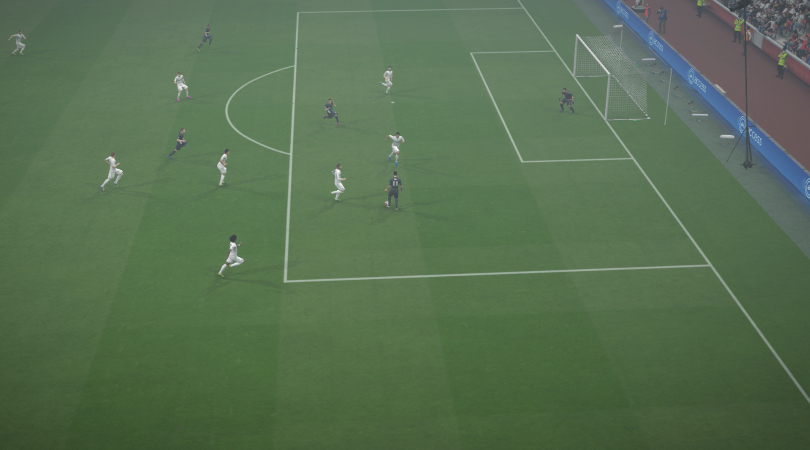
It’s something of an expert-grade trick, but you can also employ driven passes over short distances in the penalty area to manufacture unpredictable bounces – and then, if it falls kindly, smash the ball home with a volley or athletic strike.
14. Understand the dark arts of the driven pass
The driven pass is, it seems, the equivalent of the lofted through ball in FIFA 15: it’s the quickest way to get the ball from point A to point B, and it can be maddening to see a lucky bounce put a striker through on goal after you’ve had his team-mates penned into their half for the best part of a minute. Played correctly, this percentages-based style of play can be really hard to defend against. Get to the ball first, and a poor first touch can give a striker an easy tackle; be too slow to react, and it might sit kindly.
From a goalmouth siege to a near-lethal transition in an instant with a single driven pass from defence. With the defenders struggling to get the ball under control, Benzema almost steals it for a clear run on goal...
And finally...
Not everyone has the patience or inclination to perfect a passing game: some simply prefer the exuberance and intensity of box-to-box action. This doesn’t mean that they don’t have the wit and accumulated wisdom to see exactly where you intend to go with your neat little triangles, though, so try not to underestimate your opponents. The beautiful game takes a lot of work to perfect… but if you take that devotion to quixotic extremes in FIFA 16, players who successfully combine a high-intensity pressing game with fast counter-attacks can and will destroy you.
The holy grail for a passing purist: the point where, after enduring an extended spell of near-perfect possession, an opponent gives up all pretence of playing football and frantically attempts to murder your players with slide tackles.
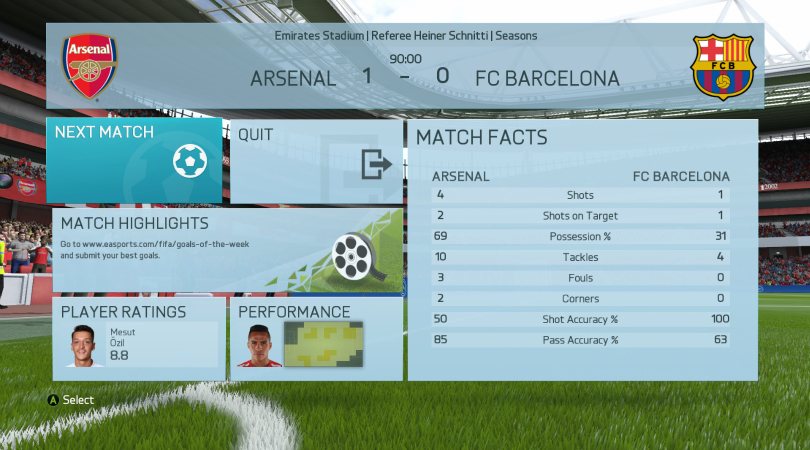
The sad reality for passing purists in most matches: all that possession doesn’t matter a damn if you can’t create and finish chances against packed defences. The stats don’t tell the whole story here: Barcelona’s counter-attacks were excellent, and they were unlucky not to walk away with at least a point...
